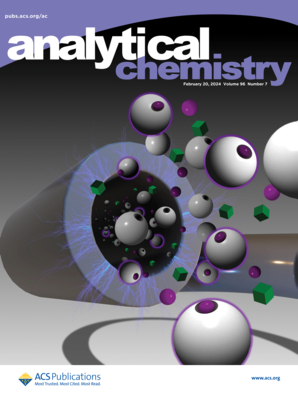使用中红外激光光谱快速高灵敏度分析甲烷团块同位素(Δ13CH3D和Δ12CH2D2)
IF 6.7
1区 化学
Q1 CHEMISTRY, ANALYTICAL
引用次数: 0
摘要
中红外激光吸收光谱能够快速无损地分析甲烷团块同位素。然而,目前的分析方法需要20 mL STP (0.82 mmol)纯CH4气体的样本量,这大大限制了其在自然样品中的应用。为了提高甲烷团块同位素的光谱测量性能,我们建立了一个激光光谱平台,并选择了新的团块同位素分析光谱窗口:12CH2D2为1076.97 cm-1, 13CH3D为1163.47 cm-1,并定制了进气系统。通过对870-3220 cm-1波长范围内新记录的高分辨率傅里叶变换红外(FTIR)光谱进行广泛的光谱调查,确定了这些光谱窗口,从而解决了现有光谱数据库中12CH2D2的空白。此外,我们实施了几项关键技术进步,从而实现了卓越的控制和样品进样和分析性能。我们证明,对于3至10 mL (0.12-0.41 mmol) CH4气体的小样本,通过使用循环再填充系统在几小时内进行3至8次重复测量,可以实现与Δ12CH2D2(~ 1.5‰)的高分辨率同位素比质谱法相当的测量精度。大于10 mL的样品可在20 min内定量。同时,Δ13CH3D分析的重复性为0.05‰,优于质谱分析。这些在减少样本量和缩短分析时间方面的进步显著提高了测定天然甲烷样品团块同位素特征的光谱技术的实用性,特别是对于涉及低CH4浓度或需要连续分析的应用,这些应用与自动化预富集系统相结合是可行的。本文章由计算机程序翻译,如有差异,请以英文原文为准。

Rapid High-Sensitivity Analysis of Methane Clumped Isotopes (Δ13CH3D and Δ12CH2D2) Using Mid-Infrared Laser Spectroscopy
Mid-infrared laser absorption spectroscopy enables rapid and nondestructive analysis of methane clumped isotopes. However, current analytical methods require a sample size of 20 mL STP (0.82 mmol) of pure CH4 gas, which significantly limits its application to natural samples. To enhance the performance of spectroscopic measurement of methane clumped isotopes, we established a laser spectroscopic platform with newly selected spectral windows for clumped isotope analysis: 1076.97 cm–1 for 12CH2D2 and 1163.47 cm–1 for 13CH3D, and a custom-built gas inlet system. These spectral windows were identified through an extensive spectral survey on newly recorded high-resolution Fourier transform infrared (FTIR) spectra across the wavelength range of 870–3220 cm–1, thereby addressing gaps for 12CH2D2 in existing spectral databases. In addition, we implemented several key technological advances, which result in superior control and performance of sample injection and analysis. We demonstrate that for small samples ranging from 3 to 10 mL (0.12–0.41 mmol) of CH4 gas, a measurement precision comparable to high-resolution isotope ratio mass spectrometry for Δ12CH2D2 (∼1.5‰) can be achieved through 3 to 8 repetitive measurements using a recycle-refilling system within a few hours. Samples larger than 10 mL can be quantified in under 20 min. At the same time, for Δ13CH3D analysis a repeatability of 0.05‰, superior to mass spectrometry, was realized. These advancements in reducing sample size and shortening analysis time significantly improve the practicality of the spectroscopic technique for determining the clumped isotope signatures of natural methane samples, particularly for applications involving low CH4 concentrations or requiring consecutive analyses, which are feasible in conjunction with an automated preconcentration system.
求助全文
通过发布文献求助,成功后即可免费获取论文全文。
去求助
来源期刊

Analytical Chemistry
化学-分析化学
CiteScore
12.10
自引率
12.20%
发文量
1949
审稿时长
1.4 months
期刊介绍:
Analytical Chemistry, a peer-reviewed research journal, focuses on disseminating new and original knowledge across all branches of analytical chemistry. Fundamental articles may explore general principles of chemical measurement science and need not directly address existing or potential analytical methodology. They can be entirely theoretical or report experimental results. Contributions may cover various phases of analytical operations, including sampling, bioanalysis, electrochemistry, mass spectrometry, microscale and nanoscale systems, environmental analysis, separations, spectroscopy, chemical reactions and selectivity, instrumentation, imaging, surface analysis, and data processing. Papers discussing known analytical methods should present a significant, original application of the method, a notable improvement, or results on an important analyte.
 求助内容:
求助内容: 应助结果提醒方式:
应助结果提醒方式:


